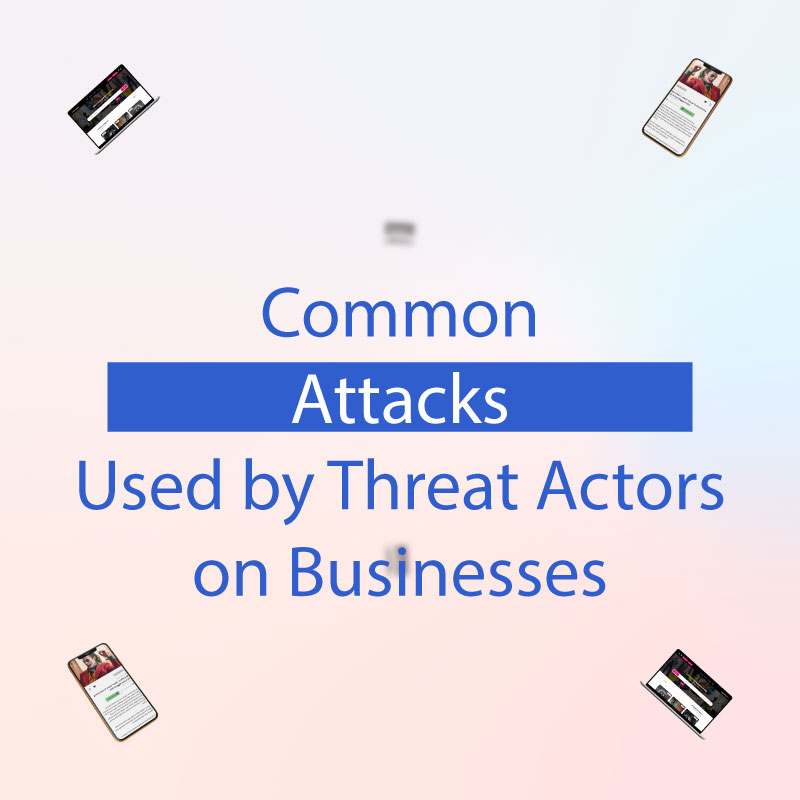Common Attacks Used by Threat Actors on Businesses
As businesses increasingly rely on digital technology, they also become more vulnerable to cyber attacks. Threat actors, or individuals or groups who carry out cyber attacks, use a variety of tactics to steal sensitive information, disrupt operations, and damage reputations. Understanding these common attacks and how to mitigate them is critical for businesses of all sizes.

One of the most common attacks used by threat actors is phishing. Phishing is a type of social engineering attack that uses emails or text messages that appear to be from a legitimate source, such as a bank or a government agency, to trick people into providing personal information or clicking on a malicious link. To mitigate the risk of phishing attacks, businesses should educate their employees on how to identify and avoid phishing attempts, and use anti-phishing technologies such as email filters and browser extensions.
Another common attack used by threat actors is ransomware. Ransomware is a type of malware that encrypts a victim's files and demands payment in exchange for the decryption key. Ransomware attacks can cause significant disruption to business operations, and can also result in the loss of important data. To mitigate the risk of ransomware attacks, businesses should maintain regular backups of their data, and use anti-ransomware technologies such as endpoint protection software.
Threat actors also commonly use Distributed Denial of Service (DDoS) attacks to disrupt business operations. DDoS attacks involve overwhelming a website or network with traffic from multiple sources, making it inaccessible to legitimate users. To mitigate the risk of DDoS attacks, businesses should use DDoS protection services and ensure that their network infrastructure is capable of handling a high volume of traffic.
Another common attack used by threat actors is SQL injection. SQL injection is a type of attack that involves injecting malicious code into a website's database, which can allow an attacker to access sensitive information. To mitigate the risk of SQL injection attacks, businesses should use parameterized queries and input validation, and conduct regular penetration testing to identify vulnerabilities.
Lastly, businesses should also be aware of social engineering attacks, which exploit human psychology to manipulate individuals into revealing sensitive information or performing unwanted actions. Businesses should educate their employees about these types of attacks and implement security protocols such as multi-factor authentication.
In conclusion, cyber attacks are a growing concern for businesses of all sizes. By understanding the common tactics used by threat actors, businesses can take steps to mitigate their risk and protect themselves from potentially devastating attacks. This includes educating employees, implementing security protocols and using anti-phishing, anti-ransomware, DDoS protection, penetration testing and multi-factor authentication.
One of the most common attacks used by threat actors is phishing. Phishing is a type of social engineering attack that uses emails or text messages that appear to be from a legitimate source, such as a bank or a government agency, to trick people into providing personal information or clicking on a malicious link. To mitigate the risk of phishing attacks, businesses should educate their employees on how to identify and avoid phishing attempts, and use anti-phishing technologies such as email filters and browser extensions.
Another common attack used by threat actors is ransomware. Ransomware is a type of malware that encrypts a victim's files and demands payment in exchange for the decryption key. Ransomware attacks can cause significant disruption to business operations, and can also result in the loss of important data. To mitigate the risk of ransomware attacks, businesses should maintain regular backups of their data, and use anti-ransomware technologies such as endpoint protection software.
Threat actors also commonly use Distributed Denial of Service (DDoS) attacks to disrupt business operations. DDoS attacks involve overwhelming a website or network with traffic from multiple sources, making it inaccessible to legitimate users. To mitigate the risk of DDoS attacks, businesses should use DDoS protection services and ensure that their network infrastructure is capable of handling a high volume of traffic.
Another common attack used by threat actors is SQL injection. SQL injection is a type of attack that involves injecting malicious code into a website's database, which can allow an attacker to access sensitive information. To mitigate the risk of SQL injection attacks, businesses should use parameterized queries and input validation, and conduct regular penetration testing to identify vulnerabilities.
Lastly, businesses should also be aware of social engineering attacks, which exploit human psychology to manipulate individuals into revealing sensitive information or performing unwanted actions. Businesses should educate their employees about these types of attacks and implement security protocols such as multi-factor authentication.
In conclusion, cyber attacks are a growing concern for businesses of all sizes. By understanding the common tactics used by threat actors, businesses can take steps to mitigate their risk and protect themselves from potentially devastating attacks. This includes educating employees, implementing security protocols and using anti-phishing, anti-ransomware, DDoS protection, penetration testing and multi-factor authentication.





